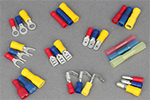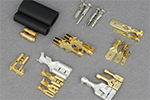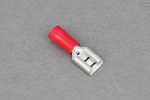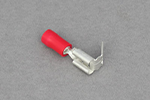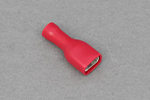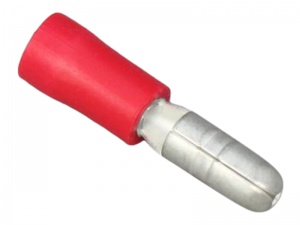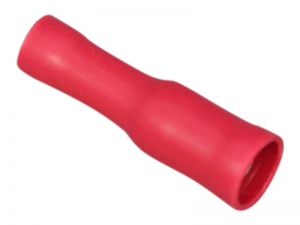| Terminals & ConnectorsToday we will be taking a look at some of the different types of terminals and connectors commonly used in 12 volt electrical installations. Often overlooked, these are one of the most important items of your system as they allow you to transfer power from one cable to another, so making sure you have the correct one can save you time, money and problems in the long run. With so many types, styles and variations however, it can be difficult to determine what terminal you need. In this guide, we will walk you through the options to help you better understand this critical component in 12 volt electrical systems. Terminal or connector? Firstly, let's understand the terminology. The terms 'terminal' and 'connector' are often used interchangeably, but we prefer to think of a terminal as something that fits to the end of a cable and enables that cable to be connected to a piece of equipment, whereas a connector is something that enables two cables to be joined together (i.e. it fits to the ends of two cables). The different types of terminals and connectors There are a number of different options when it comes to terminals and connectors and in this section we will explain the different types. Each type will have different characteristics that will make it best suited to specific applications, so you should consider carefully what's required of the connection what environment it will be used in. The table below shows the different types of terminals and connectors typically seen in cars, campervans, motorhomes, caravans, canal boats, yachts, off-grid & other 12 volt applications, together with an image and a brief description.
The different styles of terminal ends Although the characteristics of the terminal types differ, you will notice that the ends of them, i.e. the part that connects to a piece of equipment, are often common or standardised. This is essential so that you can connect different terminal types to the same piece of equipment. These standardised end connections come in the form of 'push-on' connections, that rely on friction between the connecting parts to hold the terminal in place, or 'bolt-on' connections, that rely on the terminal being clamped in place with a nut over a threaded stud, or with a screw. Some terminal types are available with different styles of end connection whilst others are only available with one style. In the table below we show a range of end connection styles that are available, using our insulated terminal type as an example.
Fitment for different cable sizes As well as catering for different connection end styles, terminals and connectors need to accommodate different cable sizes that you might need to fit them to. All the above terminals and connectors use crimping to secure the cable, which means that the part of the terminal surrounding the cable has force applied to it by a crimp tool to deform it, trapping the cable under pressure and ensuring good mechanical and electrical connections. But to ensure this is successful with different cable sizes the cable-end of the terminals needs to be slightly different depending on the cable size being used. For insulated terminals and adhesive-lined heatshrink terminals, the colour of the insulating sleeve acts as a quick reference guide to identify what cable size range it suits, which is as follows:
For non-insulated terminals the fitment range is typically the same as for insulated terminals (i.e. 0.5-1.5mm², 1.5-2.5mm², 3-6mm²) but since there's no colour coding and the terminals are rarely marked it's difficult to work out what cable size a particular terminal suits just be looking at it. For this type of terminal, your retailer should indicate on the packaging what cable size they are to be used with. Copper tube terminals are used with larger cable sizes and a particular terminal will generally only fit one cable size rather than a range (e.g. 10mm², 16mm², 25mm² etc.). The cable size and connecting hole diameter are normally stamped onto the the terminal and will be shown as 25-6, for example, which means it suits 25mm² cable and has a 6mm dia. connecting hole hole. This makes for easy identification. What size should I pick? So now you know how to choose the correct terminal based upon the cable size you want to use, how do you know what end connections type and size to pick? Well you simply need to measure the matching connector on the piece of equipment you're connecting to. As we can see from above, blade, fork & ring terminals are available in various sizes of blade/fork width or ring diameter to suit most applications. If you are unsure, you can use calipers to measure the connection point on the equipment, for example the width of the matching blade or the diameter of the bolt. If you're creating your own connection with, say, male and female blade terminals, or male and female bullet terminals, you would just need to make sure that both terminals have matching widths/diameters. Should I crimp or solder? We always recommend crimping for most applications, especially automotive, because solder can work-harden and crack over time when subject to vibrations experienced in vehicles. This can lead to poor electrical connection, increased electrical resistance and eventual failure of the solder joint. Soldering can be used where there is no alternative (e.g. the connection point is designed to be soldered) and it can sometimes be useful to solder in addition to crimping (e.g. for added mechanical strength and improved electrical conductivity), but in most cases crimping alone is perfectly adequate, as long as you use a good quality crimping tool. To learn more about this you can read our crimping tool guide here So how do I pick the best terminal for me? From the above we can see that selecting the best terminal really comes down to two key considerations which are the size of cable you're crimping to and the style/size of the connection point on the piece of equipment you're connecting to. If you're creating a connection between two cables then it would be down to a choice between a permanent or removeable connection and the style of terminal (e.g. butt connector, blade, bullet). You might also want to consider factors such as whether you want to inspect the crimp, whether it needs to be protected from the environment etc. as these might influence your decision. We hope you have found this article helpful. If you have any further questions please contact our support team. Disclaimer - The information contained in these articles is provided in good faith and we do our best to ensure that it is accurate and up to date, however, we cannot be held responsible for any damage or loss arising from the use or mis-use of this information or from any errors or omissions. The installer is ultimately responsible for the safety of the system so if you are in any doubt, please consult a qualified electrician. |
12 Volt PlanetAuto & Marine Electrical Components |


